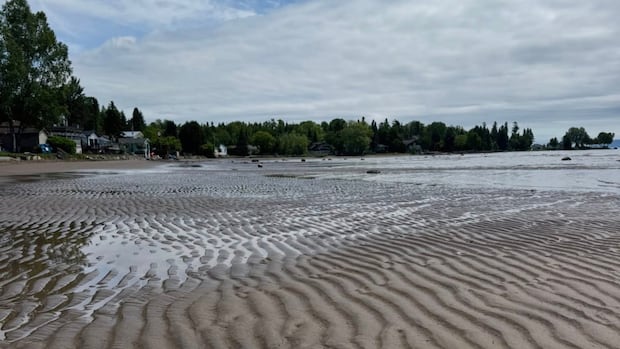[
Alan Auld of Shuniah, Ont., said he stepped out to look at Lake Superior on Saturday and was among people who saw the waters receding — something he compared to the draining of a bathtub.
“At first we joked to everyone saying, ‘Who pulled the plug?'” said Auld.
“To see Lake Superior, the largest freshwater lake in the world, can do something like that, that’s quite powerful. So we were in awe.”
On the east border of Thunder Bay, Shuniah is a municipal township along Lake Superior’s northern shoreline.
The massive fluctuations in water levels have also intrigued multiple scientists, who think the area experienced a meteotsunami — a type of tsunami wave that can cause water levels near shorelines to rise and fall rapidly.
While traditional tsunamis are caused by seafloor movement like earthquakes, meteotsunamis are linked to fast-moving weather conditions such as thunderstorms.
A big change in air pressure accompanied with high wind speeds can play into generating a meteotsunami wave, said Eric Anderson, an associate professor at the Colorado School of Mines who has been studying meteotsunamis for over a decade.
Anderson said researchers are analyzing atmospheric conditions and water-level data to figure out what happened last weekend.
“We have enough evidence to say that this was a meteotsunami-like event,” he said.
In order to officially confirm it was a meteotsunami, Anderson said, researchers need to create a computer model that simulates how the waves move around inside the lake, which will take some time.
Seiche or meteotsunami?
Auld and others who saw the water-level fluctuations thought it was a seiche.
Anderson said a seiche is a standing wave that oscillates, like water sloshing back and forth in a bathtub. In Lake Superior, a seiche period would last about eight hours, he said.
Anderson said the event Saturday occurred too fast to be a seiche and was more consistent with a meteotsunami.
He said meteotsunamis are propagating waves that move through the water — like a wave that starts at one end of the lake and ends at another — and have a much quicker timeframe, lasting minutes to an hour or two.

On Saturday, water-level gauges recorded changes of tens of centimetres to a metre on Lake Superior, the researcher said.
“That’s a huge amount of water change. This is a big one.”
It’s rare for a meteotsunami of that scale to happen on Lake Superior — it occurs perhaps a couple of times a decade at most, Anderson said. While he’s not aware of any fatalities or damage, he said Saturday’s event could have easily resulted in drownings.
“This is kind of on par with our most catastrophic” meteotsunamis, he said.
Meteotsunamis dangerous: experts
While rare, it’s important for people to be aware of meteotsunamis because they can be dangerous, said Chin Wu, a professor at University of Wisconsin in Madison who has expertise in meteotsunamis.
Shuniah, Ont. resident Alan Auld submitted this video of the water levels fluctuating in front of his house. Scientists say they think the video shows a meteotsunami, which is a type of large wave tat can be caused by atmospheric pressure changes.
Wu said there have been multiple incidents of meteotsunamis resulting in fatalities. People on beaches and piers can be swept away during periods of water level fluctuation, he added.
“The potential dangers are the water levels fluctuating back and forth, particularly once the water levels go up and go down as I see in the video. Once the water level goes down, they will drag the people out of the beaches and cause drownings.”
He warns against going to beaches and shorelines amid thunderstorms or rapid changes in water levels.
Researchers are still trying to figure out how to forecast when meteotsunamis might happen, Wu said.
“Similar to tornadoes, we want to make sure we can always forecast this kind of a dangerous event and warn people ahead of time.”

